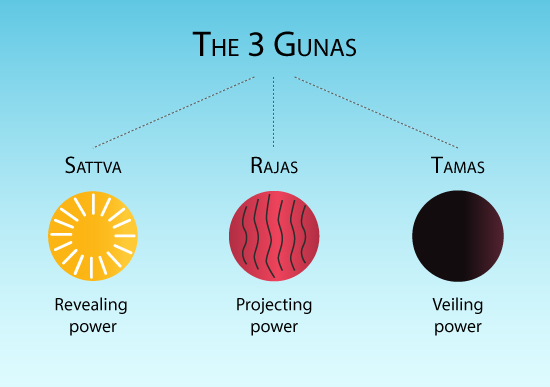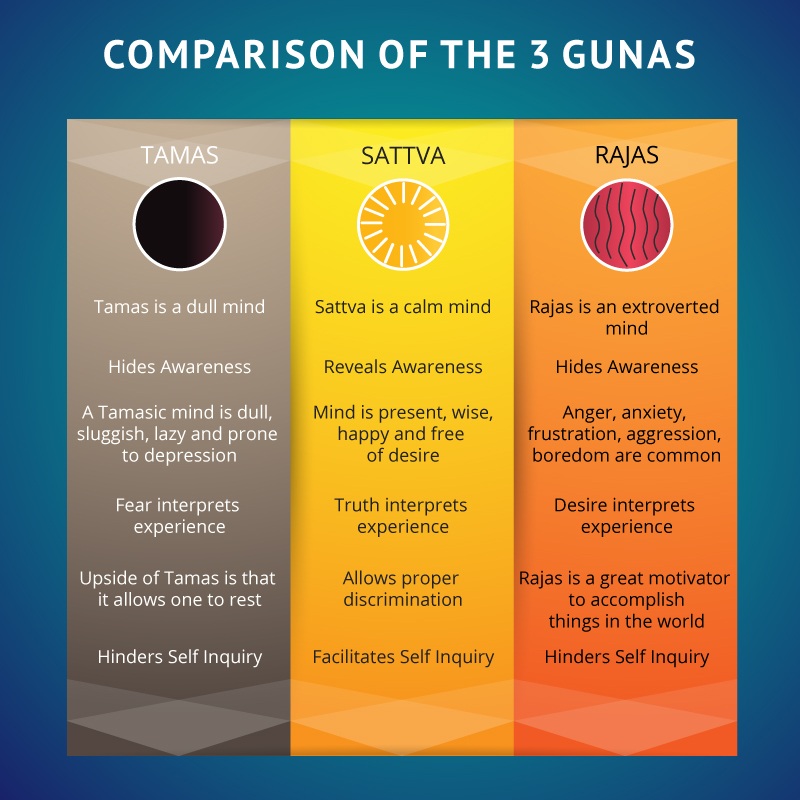Introduction
In the sub-module on Creation we discussed the 3 Gunas which exist at the macrocosmic level.
To reiterate, Sattva stands for the power of knowledge, Rajas stands for the power of action and Tamas is inertia. This describes how the Gunas work at the macrocosmic level.
In this sub-module we will learn:
1. How the Gunas operate at the level of the mind?
2. How they affect the interpretation and assimilation of our experience?
3. Why the knowledge of Gunas is important for a worldly person as well as for someone looking for liberation?
4. How to cultivate a pure, Sattvic mind, which is conducive for Self Inquiry?
5. How to balance the 3 Gunas?
6. Is it possible to remain Sattvic in a hectic worldly life?
7. Whether the 3 Gunas affect an enlightened person?
8. And lastly we will look at the misunderstanding of the Hindu caste system and its relation to the 3 Gunas.
What Are The 3 Gunas?
Gunas cause experience; in fact they are experience itself. Knowledge of them is the solution to suffering.
The Gunas and the Subtle Body
As far as liberation goes, we do not have to focus on the Gross and Causal Body.
The physical body should be reasonably healthy and one’s environment neat, clean, quiet and secure.
The Causal Body is the key to all of life’s problems, but nothing can be done about it directly because it is subtler than the mind, the doer/experiencer.
The Causal Body is understood by inference. It is transformed indirectly through the work done by the Subtle Body. This work is called Sadhana or spiritual practice.
Self-Knowledge is the direct cause of liberation, Sadhana or spiritual practice is the indirect cause. It prepares the mind for Self-Knowledge.
Firm Self-Knowledge can bring about an abiding mind, one that enjoys a steady experience of the bliss of Awareness as it reflects on the Subtle Body.
But inquirers who’s knowledge is not firm often experience the “firefly” phenomenon: the knowledge that “I am Awareness” blinks on and off as the mind changes, creating a sense of frustration.
The knowledge blinks on and off because the Subtle Body is not established in Sattva Guna. The Gunas control experience. As long as the knowledge “I am Awareness” is not firm, Gunas will control our experience.
An enlightened person is established in Awareness, and hence beyond the Gunas.
But for inquirers seeking liberation it is essential to know how to manage the Gunas, so that they can be Sattvic most of the time.
What is Sattva?
 The root of the word “Sattva” is “Sat”. “Sat” stands for Awareness.
The root of the word “Sattva” is “Sat”. “Sat” stands for Awareness.
Sattva makes knowledge possible. Nothing in creation happens without knowledge. Sattva is the revealing power, an energy that reveals Awareness.
By “reveal”, it means, it makes Awareness accessible as knowledge and experience.
If the Subtle Body was 100% Sattvic, we would experience radiant happiness all the time. Life would flow with ease. When we feel present, wise, happy and free of desire, our Subtle Body is under the influence of Sattva.
Of course being 100% Sattvic all the time is not possible because Sattva is supplanted by Rajas and Tamas as the Gunas cycle. But with a little work an inquirer can create a predominantly Sattvic mind.
Sattva is the feeling of peace and satisfaction. When we are satisfied, the mind sits still. Such a mind is invaluable because it allows us to evaluate experiences and situations objectively.
You are experiencing objects through the Subtle Body, so the energy dominating the Subtle Body at any time is of paramount importance to an inquirer.
What is Rajas?
 Rajas, the projecting power is also often called the mode of passion. On the macrocosmic level, it makes things happen.
Rajas, the projecting power is also often called the mode of passion. On the macrocosmic level, it makes things happen.
On the individual level Rajas is a spiking, agitating, extroverting energy. It makes you move physically, emotionally and intellectually.
It is desire, and the emotional agitations that follow when the desire remains unfulfilled. Anger, anxiety, frustration, hatred and aggression are all effects of Rajasic energy in the Subtle Body.
It is responsible for the feeling that there is never enough of what one wants, and too much of what one does not want. It is responsible for obsessions about what might happen.
It causes the mind to hop uncontrollably from one thought to another and limit the attention span. Attention deficit disorder is a mind completely dominated by Rajas.
Rajasic people become attached to the idea that they should be doing something all the time, and they feel guilty if they aren’t.
People controlled by this Guna are often plagued by boredom and suffer because they cannot relax.
Rajasic people evaluate themselves in terms of what they have accomplished or want to accomplish. This leads to a psychological problem of inflation and deflation.
They have an exaggerated sense of self-importance when they are getting what they want, and a sense of failure and depression when they aren’t.
When Rajas appears in the Subtle Body, it takes over from Sattva and happiness disappears. When the mind is under its influence, inquiry is very difficult.
Rajas, or desire, is the enemy of happiness. In fact the statement “I want” means “I am not happy”.
If you want to be happy, you can wait for the next period of Sattva or you can transform Rajas into Sattva.
The upside of Rajas is that it’s a great motivator. If one’s goals are clear, and other circumstances are conducive, worldly success comes quickly for those in whom this type of energy is predominant.
To say that desire is the enemy of happiness does not mean that happiness is only possible when desire is completely eliminated.
To transform the mind into one which is conducive to Self Inquiry, the desire for object happiness should be converted into desire for Self realization. What desires remain need only conform to Dharma.
Strong desires in Rajasic people often result in violations of Dharma and cause conflict. Desire need only be reduced until the actions it generates do not conflict with Dharma.
What is Tamas?
 On the macrocosmic level it is substance, matter. It is inert and insentient. It has no power to act or think.
On the macrocosmic level it is substance, matter. It is inert and insentient. It has no power to act or think.
On the individual level it is a very sluggish state of mind. Tamas means cloudy. When it emerges from the Causal Body and replaces Rajas or Sattva, it conceals the Subtle Body under a heavy dark cloud.
It is dullness, sluggishness and sloth. For e.g. the morning after a night of heavy partying or a twelve hour work shift.
It keeps you from seeing what is, as it is. It twists what you do see into what you want to see.
Tamasic people are lazy. They prefer to enjoy without doing. If you find yourself sitting in front of th T.V with a can of beer and a huge bag of fatty chips, you are in the grip of Tamas.
Criminals tend to be Tamasic in their thinking, although they may be Rajasic physically. They would rather figure out ways to beat the system than to work for a living.
This Guna inclines one to sensuality and the pursuit of short term pleasure. Alcoholics, drug addicts and gluttons are Tamasic.
Tamasic people do not want to think. Thinking is hard work. They want to follow formulas. They cannot see the value of knowledge.
People in whom Tamas is predominant want to feel. Feeling is easy. Tamasic people love sleep because it allows them to avoid unpleasant tasks. Eating large quantities of sensuous foods is an activity of choice for Tamasic people.
Extremely Tamasic people are perpetually in debt, financially and energetically. Life is a huge weight. They don’t grow; they don’t remain the same either, they devolve.
Tamas is inertia. It is the most destructive energy of the three; Rajas is a close second. Rajas is about obtaining things, and Tamas is about keeping them.
Tamasic people are messy, forgetful and prone to accidents and loss. They are perpetually confused. When the Subtle Body is predominantly Tamasic, the person feels stuck.

The 3 Gunas and Self-Knowledge
This is because a calm Sattvic mind allows you to be objective about your thoughts and feelings, and your experiences.
If you are clear about what is happening to you, and in you, you can objectively process your experiences and remove the obstacles to your happiness as they arise.
If your Subtle Body is predominantly Rajasic and Tamasic, it is virtually impossible to gain Self-Knowledge. Even if you do, it will only be a frustrating flash of insight.
Even if you are predominantly Sattvic you will not necessarily gain Self-Knowledge, but you will be in a position to develop the qualifications, assuming that you have a burning desire for liberation. (We have discussed the qualifications for Vedanta here).
So either way you have to address your experiences, not deny it or try to transcend it. You must work with it using the knowledge of the Gunas.
And if you are predominantly Sattvic, you will easily assimilate the teachings of Vedanta.
The difference between Sattva and the other 2 Gunas is that when your Subtle Body is Sattvic you can act or not act, you are not compelled to act (like in Rajas), nor are you too lazy to act (like in Tamas).
Gunatita
A Gunatita is ever in perfect balance. He craves for nothing, nor does he strive to acquire anything new. To have and not to have – both are equal to him, because he is beyond both, living a life of inward peace which is totally independent of all environments.
While a Tamas-Guna or Rajas-Guna dominant person can gradually transform to a Sattva-Guna dominant, the travel from Sattva Guna to Gunatita is different and difficult. Sattva guna cannot be converted to Gunatita. There is no corridor connecting the 3 Gunas and Gunatita.
He has to acquire knowledge through Vedanta Self-Inquiry (Shravana-Manana-Nididhyasana). In transcending the Gunas, there is no physical transformation; only through knowledge he knows that in reality, he is Gunatita.
So the main task for a Vedantic student is not to cultivate Sattva. It is to cultivate Sattva as an intermediary step to understand and assimilate the teachings of Vedanta, and eventually even transcend Sattva when Self-Knowledge is fully assimilated.
How The 3 Gunas Affect Assimilation of Experience?
Just as partially digested food inhibits the efficient functioning of the body, partially or improperly assimilated experiences compromises the development of an individual.
Experience does not interpret or assimilate itself. The intellect interprets experience. It sits behind the mind and evaluates what happens.
If experience conforms to the individual’s desire, the intellect gives the thumbs up and positive feelings arise. And if life delivers experience contrary to the individual’s desire, the intellect gives a thumbs down and negative feelings arise.
How the intellect interprets experience depends on the individual’s acquired knowledge and ignorance, plus three factors which are normally beyond its control.
Two of these factors inhibit its ability to discriminate and one facilitates it. The 3 factors over which the intellect has limited control are Rajas, Tamas and Sattva.
Rajas and Assimilation of Experience
If an individual’s values are materialistic and the mind is predominantly Rajasic, then the intellect pursues worldly goals.
If the values are spiritual, the intellect evaluates progress with reference to its idea of purity or enlightenment.
A Rajasic intellect is not concerned with the truth of experience, only in whether or not the experience relates to the fulfilment of the individual’s desire.
Whether the goals are worldly or spiritual, and whether or not they are realized, Rajas is a source of frustration because anything gained is inevitably lost. An object gained causes attachment, and an object lost produces grief, neither of which is conducive to happiness.
Because Rajas causes lack of discrimination, a Rajasic person will constantly repeat actions that produce suffering. Rajas prevents a person from learning from their experiences.
When a pleasurable experience ends, Rajas brings disappointment because it wants the pleasure to continue. If the experience is mediocre, it wants it to be better. If it is bad, it should end instantly and not happen again.
Rajas causes boredom and produces a strong desire for variety. More-better-different is its holy mantra.
A person under the influence of Rajas feels that nothing is ever completed. No matter how much is accomplished, the list of things to do never shrinks. Because it cannot sit still, it is often referred to as the monkey mind in spiritual literature.
Assimilation of experience only takes place when the mind is present. Therefore when Rajas dominates the Subtle Body, the intellect is unable to accurately determine the nature of experience and resolve doubts about it.
A resolved experience leaves attention fully present, so that it is able to engage the next experience without any influence or repercussion from the previous experience.
Because life is a sequence of continuous experiences, it is important to process each experience as quickly as possible, preferably as it happens.
Unresolved experience subliminally drains attention. Difficulty focusing on what needs to be done, and avoidance of what should or should not be done, are signs that the mind is excessively Rajasic.
As unresolved experiences accumulate, the individual feels overwhelmed, stressed and unable to keep up with life’s demands. So a Rajasic person is unable to grow spiritually because they cannot properly assimilate both wanted and unwanted experiences.
Tamas and Assimilation of Experience
Proper evaluation of experience requires mental clarity, but when a sluggish veil covers the Subtle Body, perception is distorted and assimilation is compromised.
When the intellect is dull, it has difficulty connecting the results of its actions with the thoughts motivating them. This causes uncertainty with respect to what has to be done and what should not be done.
A Tamasic mind lacks direction. “Where should I go? What should I do? What’s going on? I don’t know” are some common thought patterns of a Tamasic mind.
A Tamasic mind is a lazy mind. Unlike Rajas, it hates the new. Because creative thinking takes so much energy, the Tamasic mind does not value inquiry.
Tamas is responsible for the feelings of helplessness that cause deep and lasting depression. Tamas solves problems by denying them.
The unprocessed experiential backlog caused by a Tamasic mind causes an individual to dither and procrastinate. If you have a Rajasic lifestyle and find yourself feeling constantly exhausted, know that Rajas is causing Tamas.
When Tamas is particularly heavy, even small duties like brushing teeth, combing hair or taking out the garbage seem like big undertakings.
Sattva and Assimilation of Experience
Sattva is an indirect means of enlightenment because it makes the mind conducive to Self Inquiry.
Irrespective of its value for enlightenment, a predominantly Sattvic mind is a happy creative mind. Unenlightened but happy worldly people owe their happiness to Sattva, which they evolved unconsciously because they follow Dharma.
To gain a predominantly Sattvic mind the proportions of Rajas and Tamas relative to Sattva needs to be manipulated.
Enough Rajas needs to be retained for motivational purposes, and enough Tamas kept to ground one’s ideas in reality. But the major share of the mind should be Sattvic.
A predominantly Sattvic mind will gain success in any field, worldly or spiritual, because it can discriminate properly. Faulty discrimination causes inappropriate actions.
When Rajas dominates the mind, desire interprets the experience. When Tamas dominates, fear interprets experience. Both obscure the truth.
When Sattva dominates, truth interprets experience.
We believe that we consciously interpret our experiences, but actually Rajasic, Tamasic and Sattvic values do the interpreting.
A Sattvic mind is an inquiring, open mind. A clear mind is required to grasp the import of Vedantic teachings.
When Self-Knowledge dawns in a Sattvic mind, it is a perfect means to evaluate and process experience. Unexamined experience no longer accumulates, because it is processed on the spot, allowing the mind to retain clarity for the next experience.

How to Get a Pure Sattvic Mind?
But it is possible to create a predominantly Sattvic mind, that delivers more or less constant happiness, and one that can efficiently process experience.
1. Pay close attention to the energy in play at the moment
Rajas and Tamas are unconscious energies that thrive in the dark. They survive because they fly beneath the radar of attention and replicate themselves secretly as we act.
2. Connect actions to results
If you drink a bottle of wine you will feel stimulated (Rajasic) and momentarily happy (Sattvic), but the next day your mind will be Tamasic and filled with regret.
Discrimination is very subtle. If something agitates or dulls you, it has to be renounced. You cannot just keep doing what you are doing and somehow expect your mind to become pure.
Once you find yourself acting out a particular Guna, just observe what is going on. Don’t judge or beat yourself up, be dispassionate about whatever is going on. Trace back the train of events, thoughts and feelings to their source and identify what triggered them.
This is Self Inquiry, the work of keeping an eye on our likes and dislikes. Make a note of the Guna and adjust it in the light of what kind of mind you are trying to create.
Each time you do this, it will get easier to manage them and it will be easier to recognize them quicker when they appear as your likes and dislikes.
This is how you identify the Vasana (We discussed Vasanas in The 3 Bodies sub-module) because the Gunas and Vasanas are hidden in the Causal Body. With repeated practice you will have de-activated the like or dislike, i.e. your Vasana. It will no longer have power over you, though it may still appear in your Subtle Body.
3. Recognize that life is a zero-sum game
It makes me feel good. But why do I want to feel good?
Because I do not feel good as I am. Something is missing. I feel dull, bored and unfulfilled. I need some fun.
So I get drunk and my problems go away. But the next morning I have the same problems I had the day before.
Chasing pleasure did not solve my problem. Feeling good is not the solution. So I better have a look why I feel bad in the first place.
To make a meaningful change one needs to realize that life is a zero-sum game. God has set up this unbeatable system. Every upside in life has its downside. (We covered this topic extensively in sub-module The Fundamental Problem)
4. Self Inquiry is the solution
If you are here, you are a doer. You move till the day you die. You have choice over your actions, but you are compelled by your Karma to act.
Self Inquiry is the way out. It is the power to recognize Rajasic and Tamasic thoughts and neutralize them. You neutralize them with the understanding that they prevent happiness and assimilation of experience.
The person who drinks to get rid of his suffering does not know the source of his suffering. He feels incomplete, but he does not know why.
Therefore he assumes incorrectly that there is an experiential solution. Although he intellectually knows that his solution does not work, he cannot break his habit.
The alcohol tendencies are binding; they compel him to drink when he feels anxious, angry, bored or depressed.
When he is agitated (Rajasic), he relies on alcohol to relax him. It does not relax him, it only makes him dull. But the dullness seems like peace compared to anxiety.
When he is dull, he relies on alcohol to lift his spirits. It does not really lifts his spirits, it just stimulates his nerves for a short time. However it feels a lot better than depression.
When you are caught in the Rajas-Tamas cycle, you are not happy and cannot assimilate the knowledge you gain from experience. Therefore cultivate Sattva.
5. Have a simple lifestyle
Less is more on the path of Self Inquiry. A simple lifestyle is necessary if Inquiry is going to work.
Inquiry begins when we look into the excuses we make to avoid simplifying our lives. Tamas will try to scare you as it does not like change.
6. Cultivate Sattvic values
Sattvic values facilitate Inquiry and growth, whereas Rajasic and Tamasic values inhibit it. So it’s necessary for anyone seeking happiness or liberation to make an inventory of one’s values, both positive and negative.
Inquiry cannot take place in an emotionally disturbed mind. The mind suffers agitation or dullness when a negative value is in play.
It is unrealistic to expect negative values to disappear overnight, but as you consistently examine and renounce negative values, the mind becomes extremely subtle, and then Self Realization is inevitable.
You renounce negative values by cultivating positive, Sattvic values. In the module “Universal Values” we explained the 20 values mentioned in the Bhagavad Gita. Assimilating these values will help in developing a Sattvic mind, one which is suited to Self Inquiry.
7. Monitor your diet
A Tamasic diet creates sleepy, dull thoughts and depressing feelings. A fried steak is an example of a purely Tamasic diet.
Many bitter and astringent foods are Rajasic. A very popular Rajasic food is coffee. Rajasic foods artificially activate the mind and produce Tamas. Sugar also provides bursts of Rajasic energy in the short run, but becomes Tamasic as it passes through the system. The depressions suffered by alcoholics are sugar induced.
Most fruits and vegetables are Sattvic. Some flesh like fish and chicken are also relatively Sattvic. Try to eat fresh food. Refrigerated food tends to be Tamasic.
We’re not going to give a list of Sattvic, Rajasic and Tamasic foods because everyone is affected differently by various foods. Monitor how your body reacts to various foods, and then reduce your consumption of foods that make you Rajasic and Tamasic.
Why Balancing The 3 Gunas Is Important?
Without Rajas you would never get out of bed in the morning or accomplish anything. Rajas is the active, creative force, the mode of passion.
Not all desire or passion is bad. You need passion for Self Inquiry and a strong desire for liberation, which is one of the qualifications of Vedanta (discussed in sub-module 4.1.3).
Tamas is a heavy, steady energy. Without it you will not be capable of endurance. You would not have the staying power to complete anything. You would not be earthed. And you would never be able to sleep.
With too much Sattva you can get stuck in a golden cage of experiential bliss. Sattva is not the ultimate goal of Self Inquiry. Sattva is a state of mind that is experienced by the doer, the Subtle Body. It is purely experiential and therefore does not last.
It will certainly not free you from dependence on objects or end the subtle existential suffering that comes with it. Yet it is a valuable energy for inquiring and should be cultivated.
If you are not careful Sattva can also give you a spiritual ego, the feeling that you are pure and holy. It can make you spiritually vain.
Is a Sattvic Lifestyle Possible in Business?

(This is a Satsang written by Tan, a Shining World endorsed teacher of Vedanta.)
Robert: Hi, Tan.
A question popped up while listening to one of James’ satsangs in which he was talking about a sattvic lifestyle, which is necessary for self-inquiry. His advice was to avoid people that are too tamasic or too rajasic, because of their influence.
Tan: Hi, Robert.
A sattvic lifestyle has the target of creating a subtle body that is predominantly sattvic, which has two main results:
1. Feelings of bliss and happiness: The reflection of the self can be experienced by the mind, more easily leading to life full of experiences and feelings of bliss and happiness. This is what yoga can create. But this can also be risky business if the yogi gets attached to sattva and becomes a bliss junkie who is no longer looking for moksa but for bliss, thereby mistaking bliss for moksa. Bliss is not moksa. Moksa is the freedom from the need for bliss.
2. Qualifications for self-inquiry (sadhana catustaya): A sattvic subtle body more or less should have the qualifications required for successful self-inquiry, such as:
[a] the capability of discriminating between the transient and eternal (nitya anitya viveka),
[b] indifference to the fruits of action (karma phala vairagya),
[c] control of the mind and senses, power of concentration, spirit of renunciation, acceptance of one’s dharma, fortitude, faith pending results, i.e. trust in the scripture (samadi shatka sampati).
Now , a sattvic lifestyle consists of multiple facets:
- A sattvic environment, which includes sattvic people and sattvic places (e.g. a clean home, tidy workspace, well-kept clothes).
- Sattvic activities for your body , such as eating sattvic foods, cleanliness, exercise, etc.
- Sattvic activities for the mind, which should be dharmic activ ities, such as self-inquiry , study of scripture, prayer, etc.
This means that if you cannot avoid a rajasic or tamasic environment (e.g. people or places), there are other multiple areas that you can work on to create a sattvic lifestyle.
Nevertheless, if you can avoid rajasic or tamasic people it is good do to so.
In the Vedas highly rajasic people are called “raksasa.” They have a lot of ambition, which fills their day with activities and vanity. In the process of fulfiling their ambitions they destroy anyone or anything in their path because in their mind the end justifies the means. There are many raksasas in the corporate world. The typical goal of the corporate raksasa is profit and power, and he will intrigue, destroy and assimilate any competitor in his way. Because of his lack of discrimination, he cannot appreciate the self and Isvara. This lack of seeing anything holy in this world leads to this demonic behaviour.
Highly tamasic people are called “asuras”; they will eat or drink anything. There are no rules at all. They will have untidy homes, they will passively watch TV while eating leftover pizza from two days ago.
Robert: But how can you practically do this when you have to earn a living every day?
In your own case, for example, if I remember well, you’re a businessman, so I guess there are many very rajasic people you have to deal with. How can you maintain a sattvic lifestyle in a business environment?
Tan: Well, you can select your work environment. Not every work environment has the same level of rajas and tamas. Also, there is a difference between whether you are employed or self-employed. Obviously your degree of freedom increases with self-employment. You can choose whether you will work for a rajasic client or not.
As an employee, you can also try to identify the work place or the department that is less rajasic.
Once I had changed to a new work environment. My main motivation was apparent security (income) and apparent respect (position). The work environment, however, was so rajasic that my mind and my discrimination suffered badly, which was not worth only apparent security and respect. I changed that environment.
A peaceful, sattvic mind is more valuable than apparent security or pleasure because – as mentioned above – a rajasic or tamasic mind cannot really have a blissful experience for long, since after each goal the next one awaits. And since it is always disturbed and not a peaceful inner instrument (antah karana suddhi) anymore, it is not supportive of self-inquiry and the path to moksa, which is w hat we Vedantins want.
Regardless of whether your mind is enlightened or not, it is going to suffer in a rajasic environment. Self-knowledge can be firm but still, rajas and tamas have their disturbing impact on the mind.
Now, regarding your questions about what I did during my self-inquiry, I would like to point out that my life is not an example that can be copied, since every jiva has its own karma and dharma, but I will list a few things I did.
Although I was a manager at a firm with a rajasic environment, I tried to incorporate many sattvic elements into the daily routine:
- Food: I ate vegetarian and vegan.
- Exercise: I practised meditative exercises (like tai chi and qi gong) daily .
- Thinking: I read Vedantic texts daily and watched James’ videos.
And I took time off work, sometimes just a day or two. But on those days I went into solitude in a cottage just for self-inquiry with my Vedic scriptures and James’ satsangs to read and contemplate.
But I would recommend reading the satsangs on the gunas at the ShiningWorld website. There are some very detailed satsangs by Sundari on them. You should create your own list of sattvic elements that are a good fit for you to incorporate into your life.
I do not think it makes sense for me to give you lifestyle tips; you have to decide the right actions to create a sattvic lifestyle for yourself.
Robert: It’s impossible to avoid these people – I don’t even think I would really want to, that is, not always.
But maybe there is some kind of self-protection possible, and if so, how do you do this?
Tan: Yes, it is impossible to avoid rajasic or tamasic people, because the world (maya) is made up of the gunas. And we should also not condemn rajas and tamas per se. Rajas is needed to create, and tamas is needed to recuperate. All gunas have their positive and negative side.
The most beautiful works of art need rajas to be created. The Mona Lisa was done through rajas. Rajas builds ashrams, such as the ones of the Chinmaya Mission and Swami Dayananda.
In terms of your question on self-protection, the self needs no protection. It is trigunatitam, beyond the gunas. Each time you see rajas or tamas, you can discriminate between yourself, consciousness, and the gunas. This will help to keep your mind fixed on the self. But if the environment is so rajasic or tamasic that your mind loses its quality of discrimination, you may need to change your environment.
Robert: Thank you very, very much for your long and very interesting answer. This helps a lot!
Are there Gunas for an Enlightened Person?
They condition the Subtle Body 24/7. Liberation or Self- knowledge means that you have assimilated the knowledge that you are whole and complete, that the person you seem to be walking around as is no more than a notion in you, Awareness.
When you know who you are, in other words when ignorance of yourself as Awareness has been removed by Self Knowledge, Maya (macrocosmic ignorance and its effects) still obtains and the Gunas continue to condition the Subtle Body (the person ). . . but they are rendered unbinding and the doer is negated by the knowledge.
They do not bother you, Awareness, because you know that you are not the Subtle Body, the person/doer.
The Gunas And The Hindu Caste System
What is Varna?
In the Vedas, material success is not neglected, and is also given mention along with spiritual success, but mere materialistic goals are meaningless. They should be equally balanced with spiritual goals.
Nothing works well without an infrastructure. We need it for almost everything; ranging from the educational system, to the transportation system, for the smooth functioning of society.
The infrastructure given in the Vedas is the Varna Dharma, which is a sociological scheme for the growth of society as a whole.
The Classifications
Each of these divisions is further sub-divided into four based on Gunas:
1. Personality based classification
a. Brahmana
Being primarily Sattvic, this person loves spiritual pursuits, withdrawal, contemplation, knowledge etc. The pursuits of the other goals are only incidental, that come as a part and parcel of human life.
Sannyasa or renunciation appeals to such a mind. While solitude is a dreadful thing for most people, such a spiritual person rejoices in it.
b. Kshatriya
This person has a dynamic personality; outgoing, active and highly motivated in a selfless way. He has a selflessly motivated mind that works in the direction of exercising his power in service of others.
c. Vaishya
This person has a selfishly dynamic personality; business oriented, for service of oneself and for one’s own family.
d. Shudra
This person has no motivation either for materialistic or spiritual goals. Passive and lethargic, his main goal in life is mere survival, with neither the inclination towards knowledge like a Brahmana, desire for social service like a Kshatriya, nor desire for self gain like the Vaishya.
Thus we see that the predominance of certain Gunas endow an individual with different types of personalities. In an ideal situation, a person is most fit to perform a job which corresponds well with his personality.
This gives rise to a division based on one’s occupation (Karma Vibhaga).
2. Occupation based classification
a. Brahmana
Someone needs to teach Vedas, and it is a highly responsible task, where not only does one need to learn the scriptures very well, but a detailed knowledge of Sanskrit, treatises on logic, and other related works are needed too.
Such a teacher must also be able to express the knowledge of the scriptures effectively, and be up to date in order to be able to communicate it to a generation of modern minds.
b. Kshatriya
Government ministers, police officers, legislators are a few positions that a Kshatriya holds. Though this is far from the case today, in an ideal situation the job of a Kshatriya is to selflessly serve people.
c. Vaishya
d. Shudra
There is a lot of stigma attached to the term Shudra, but taking a look at society objectively, we come across some people who are academically interested, some who are endowed with strength and possess a disposition to serve others, some who have a capacity to handle business, and then we have some who are some aren’t.
Based on each individual’s qualification, they are thus classified.
3. Social Group based classification
Varna and its Symbolism in Hinduism
The correct way of understanding the symbolism is as follows:
If such symbologies are misinterpreted they can prove to be detrimental to one’s attitude towards religion.
Scriptures abound with examples where the focus is on one’s personality, and not birth.
Sage Valmiki, author of the epic poem Ramayana, was considered occupationally a forest bandit, but later through his own change in character, became one of the most venerated sages.
So did the son of a fisherwoman; sage Vyasa, who was respected for his merits as a teacher of Self-Knowledge, and compiler of the Vedas.
We have no choice over our birth, but we do have sufficient choice over our profession, and absolute choice over our character. Thus it is one’s character that primarily determines his or her Varna.
Summary
| 1. | Guna means “Quality”. It also means a “rope” because the Gunas bind us to experience. The Gunas control our experience. |
| 2. | Sattva is the revealing power, an energy that reveals Awareness. Sattva makes Awareness accessible as knowledge and experience. When we feel present, wise, happy and free of desire, our Subtle Body is under the influence of Sattva. Sattva allows us to evaluate experiences and situations objectively. |
| 3. | Rajas, the projecting power, is also called the mode of passion. Anger, anxiety, frustration, hatred and aggression are all effects of Rajasic energy in the Subtle Body. Rajas makes Self Inquiry difficult. |
| 4. | Tamas is the veiling energy. It conceals the Subtle Body under a heavy dark cloud. Tamas is dullness, sluggishness and sloth. |
| 5. | Sattva is an indirect means of enlightenment because it makes the mind conducive to Self Inquiry. |
| 6. | All the 3 Gunas have an upside as well as a downside. A proper balance between the 3 Gunas needs to be maintained to lead a productive life. |
| 7. | An enlightened person is beyond the Gunas because even when the Gunas are modifying the Subtle Body, the person is not identified with the Subtle Body. |


